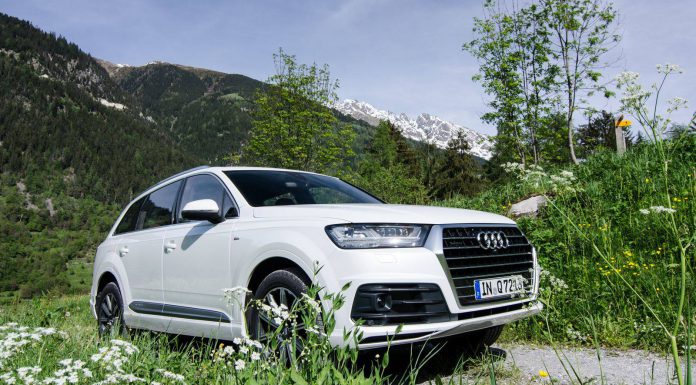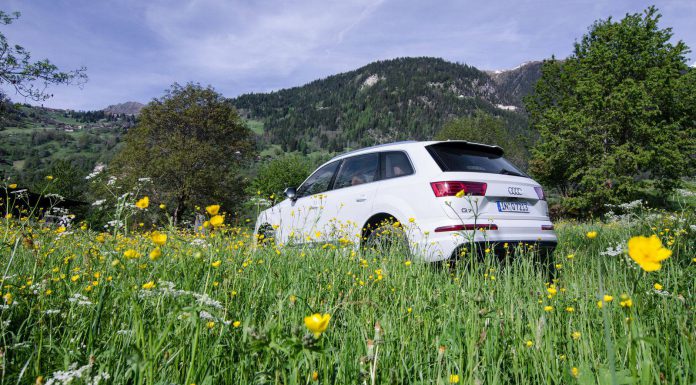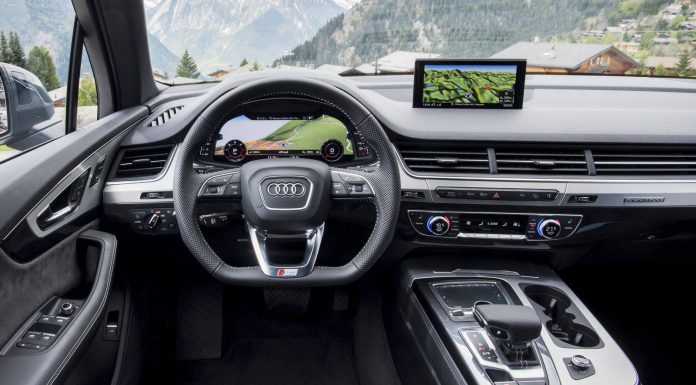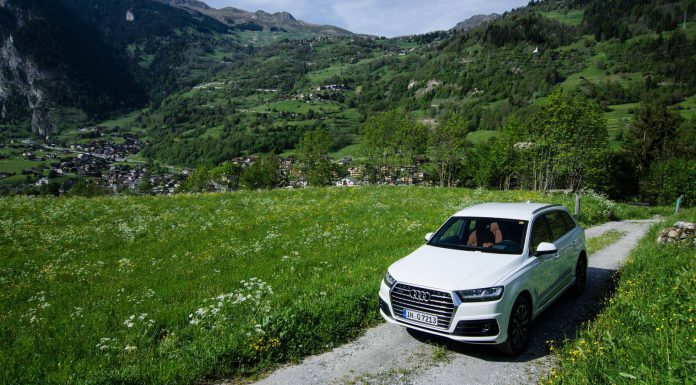“The new Audi Q7 is the benchmark in its class”. This is a phrase that has been coined time and time again in the international press introduction. It was time for us to see if such claims were made with foundation during our two days with the new Audi Q7 in Switzerland. Will it prove better than the previous Q7 and all its competitors in one of the most ferociously contested segments in the industry?
Exterior design
After a spectacular flight between the white-topped mountains we landed on a small airfield in Sion. In a hanger were dozens of new Audi Q7’s waiting to be driven at our disposal. Before jumping in behind the wheel it was time to get acquainted with the exterior. We have met the new Q7 at various shows around the globe and were weary of the new sharper aesthetics. The exterior has been designed to draw the attention of people from Asia, the Middle-East and the United States, the key SUV markets, areas that are very important for the new Audi Q7 to succeed.
[youtube]https://youtu.be/gxjNKJ-q-ME[/youtube]
The first notable styling cue, is the muscular new single frame grille. The overall exterior dimensions look (and have gotten) smaller. The application of fresher sharp edges, which you can find everywhere on the car, looks striking but certainly take some time to get used to. This smaller muscular looks reflect the leaner curb weight that has been reduced by 325 kg compared to the previous Q7. With 1,995 kg it is also the lightest in its class. To reach this weight, there has been significant re-engineering of several components, from the axles to body parts, were made lighter.
Furthermore the headlights and taillights have adopted the modern Audi design. The headlights feature a choice of with xenon, LED or Matrix LED technology lights. The daytime running lights of the LED headlights are shaped like a double arrow. The taillights of the top model include dynamic turn signals that we first saw on the R8 supercar.
Driving
After the first look it was time to pick a car. We chose the Tofana White Audi Q7 3.0 TFSI to start. This petrol engine has 333 HP and 440 Nm connected to the 8-speed triptronic gearbox. The first few metres are positive. The cars feels very comfortable and is not at all an intimidating size, the acceleration is flawless. 0-100 km/h can be done in just 6.1 seconds. With the ‘Drive Select’ in Comfort and the Adaptive Cruise Control at 120 km/h we relax the first 30 minutes on the Swiss highway. With another new Audi Q7 driving behind, we see it for the first time driving on public roads. In the stunning colour Ara Blue it is starting to grow on us.
The Adaptive Cruise Control worked perfectly and in combination with Comfort mode it feels like a very comfortable cruiser floating over the Swiss tarmac. The system also recognizes speed signs so it automatically slows down to 100 km/h or 80 km/h, when there was a road construction for example. For our lunch stop we had to leave the highway for a road that led up into the mountains around Verbier. We opted to put the car in Dynamic mode to experience if the car has a sporty side. This mode lowers the ride heights and puts the transmission in ‘S’. The steering also gets a little bit heavier and more direct.
The road was threaded into a number of hairpins that were a good test of the cornering behaviour and the acceleration while climbing. The difference between Comfort and Dynamic could be felt right away. The Q7 is hardly swayed in the tighter corners and you felt more connected to the road. An interesting fitted option is all-wheel steering. A steering system with an electric spindle drive turns the rear wheels inward by as much as five degrees depending on the situation. It feels like you are driving a train on rails because there was no detectable understeer. The 3.0 TFSI lacked torque in the lower revs when accelerating out of a corner up the hill in 2nd gear. Shifting manually from first to second and from second to third gear flowed together with a little pop and in the from the exhaust which was a pleasant surprise.
For some pictures we turned into a gravel country road. For these situations Audi offers allroad or lift/offroad mode. The Q7 raises ride height to the highest possible setting to make sure you can drive over sizable objects and obstacles. The power can be transferred between wheels to allow for as much as 70 percent of the power to go to the front and a maximum of 85 percent to the rear. Torque vectoring is also available. We set off the traction control and give full throttle. The Quattro system does its job and there is no spinning noticeable.
The second day we take out the Audi Q7 3.0 TDI with 272 hp and 600 Nm. With less horsepower than the petrol engine, but 160 Nm more torque, this should be a lot quicker in the lower revs. And it certainly was. This car was specced in Daytona grey and had the optional sports suspension. The interior was fitted with the sport seats. In combination with the dynamic mode this is the most sporty the new Q7 will get. Personally this combination was too uncomfortable for us. Nice for short sporty drive but on a long drive is would get a little uncomfortable, especially for a luxury SUV. This engine sprints from 0-100 km/h in 6.3 seconds which is just 0.2 seconds slower than the petrol varient. This diesel engine fits the new Audi Q7 the best. Power when you need it, better fuel consumption and even the engine tone is pretty good for a diesel.
Next to these engines, there is a more environmental friendly diesel available with 218 hp and 500 Nm and later this year a 373 hp e-tron 3.0 TDI will join. That second one will be the first plug-in hybrid with six-cylinder diesel and Quattro all-wheel drive. Emitting just 46 gram CO2 in the NEDC it has the best value in the segment.
Interior
Let’s take a deeper look into the interior design and infotainment features. Although the exterior dimensions of the Q7 have gotten smaller, the interior room for passengers and luggage is significantly improved. Even a sixth and seventh adult can take a seat for up to an hour drives without feeling too uncomfortable. The quality is very nice and the finish is stunning, far from boring if the right colours and materials are chosen. One of the features of the interior is a large air vent from the middle console all the way to the passenger door on the right. This makes the dashboard look larger. The huge console in the middle with the enormous gear lever remind you that you are driving a big SUV. The rest of the interior looks minimalistic due the use of only necessary buttons and space between the different groups of buttons like the 4-zone climate control, infotainment control and driving mode options.
The new Audi Q7 has the second-generation modular infotainment platform. It also has the new MMI all in touch control unit with large touchpad, expanded services from Audi connect, the Audi tablet for the rear seat passengers and the two sound systems with 3D audio. Smartphone integration with Google Android Auto and Apple CarPlay is also new. The Smartphone integration feature is more extensively than on any other car so far and works perfect with both system.
Two screens are the centres of attention when driving the new Q7. The driver can choose between the classic view, for a split screen with the navigation map in the middle, or for an almost entire navigation screen in front of you with smaller dials.
The Audi tablets are a nice USP for the new Q7. They involve the rear passenger to the vehicle information but also entertain them with all the features of a normal Android tablet. The rear passengers are also able to control the sound system that can also be blocked by the driver of course. The tablets can also be removed and taken into your own home for use. Why an Audi tablet and not two other tablets? The Audi tablet is also tested to be much safer in crash situations because the screen won’t burst into pieces during an impact. On the other side, the theft risk of this tablet seem high because there is no special place in the car to store them while your car is parked somewhere. The tablets are unique for every Q7 and need to be connected to the car after a while otherwise it will go into safe mode. Hopefully this is not easy to crack so thieves won’t be attracted.
Our test cars were fitted with the Bang & Olufsen 3D Advanced Sound System that makes a large difference over the standard Audio. The Bose 3D-Sound System is also an option this will be in between the standard audio and B&O sound quality wise.
Competitors
Direct competitors are the BMW X5, the Mercedes-Benz GLE, Volvo XC90, Porsche Cayenne and the Range Rover Sport. Design wise, you can compare it with the Volvo XC90. Sharp edges combined with modern and minimalistic tones. In term of drivability, the Porsche is still the sportiest SUV. We think the Audi Q7 is the best all-rounder of them all, closely followed by the BMW and Mercedes-Benz. Soon we will find out how the Volvo XC90 will fair in such esteemed company.
Conclusion
The new Audi Q7 really surprised us. The crash diet is the best thing that happened to the Q7 and in combination with its new design it looks and drives like you would expect. We are still trying to get used of the new look but we think it is a matter of time. The interior looks great and the infotainment system is the best of its class, a very well designed and executed vehicle indeed. The price starts from 60.900 euros in Germany.













































































